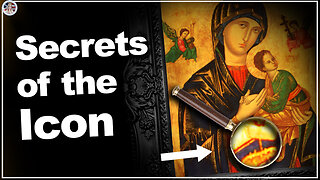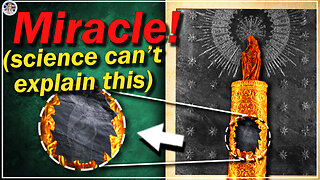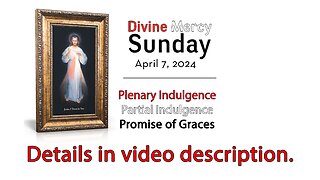Episode 1483: Woman behold thy Son
John 19:25-27
"Now there stood by the cross of Jesus, his mother, and his mother's sister, Mary of Cleophas, and Mary Magdalen. When Jesus therefore had seen his mother and the disciple standing whom he loved, he saith to his mother: 'Woman, behold thy son.' After that, he saith to the disciple: 'Behold thy mother.' And from that hour, the disciple took her to his own." - Gospel of John 19:25-27 (Vulgate, English Translation)
When reciting the sorrowful mysteries there are two parts that are very meaningful for me and they are – mother all things new again and mother behold they son. Some will ask why is it the blessed mother being the greatest person ever born and a saint is not a patron saint of something. But she actually is and that is she is over the mystical body of christ his church and christ point to that in the two expressions he made through his passion mother all things new again and mother behold they son. So on this feast day of the birth of mary it is so befitting to discuss this.
This moment is seen as a profound act of care and love that Jesus, even in the midst of his suffering on the Cross, demonstrates for his mother and for all of humanity. Here's an elaboration of this viewpoint:
Mary as Mother of the Church: When Jesus addresses Mary as "Woman," it is understood to be significant. This echoes the language used in the Garden of Eden, where God speaks of the woman who will bear the Redeemer. This phrase indicates Mary's role as the New Eve, the mother of all the redeemed.
1. Proclaimed at Vatican II: The title "Mother of the Church" was officially promulgated by Pope Paul VI during the Second Vatican Council. It was declared in the document Lumen Gentium (Dogmatic Constitution on the Church), in which Mary's role as the mother of the Church was highlighted.
2. Spiritual Motherhood: Mary's motherhood transcends her role as the mother of Jesus in the flesh. She is also recognized as the spiritual mother of all Christians. This means that she cares for, intercedes for, and guides the members of the Church in their journey of faith.
3. Association with the New Eve: Mary is often seen in Catholic tradition as the New Eve, just as Jesus is seen as the New Adam. While Eve's disobedience led to humanity's fall, Mary's obedience and cooperation with God's plan played a crucial role in the redemption of humanity through her Son, Jesus Christ.
4. Her Role in Salvation History: Mary's "yes" to the angel Gabriel's announcement of the Incarnation (known as the Annunciation) is seen as a pivotal moment in salvation history. Her fiat ("Let it be done") signifies her complete and willing cooperation with God's plan for the redemption of humanity.
5. Her Presence at Key Moments: Mary is present at significant moments in the life of Jesus and the early Church. She is there at the Annunciation, the Nativity, the Presentation in the Temple, the Wedding at Cana, and she stands at the foot of the Cross during the Crucifixion.
6. Mediatrix of Graces: While the title "Mediatrix of All Graces" is distinct from "Mother of the Church," they are often related in Catholic theology. Mary is believed to intercede on behalf of humanity, asking for God's grace and blessings for the Church.
7. Icon of Faith and Discipleship: Mary is held up as a model of faith, obedience, and discipleship. Her complete surrender to God's will and her steadfast presence at the foot of the Cross are seen as examples for all Christians to emulate.
8. Her Maternal Intercession: Catholics believe that Mary's prayers are powerful. As Mother of the Church, she intercedes for the needs of all Christians, guiding and protecting them on their journey of faith.
9. Feast of Mary, Mother of the Church: In 2018, Pope Francis declared that a new liturgical feast be celebrated on the Monday after Pentecost, specifically in honor of Mary, Mother of the Church. This emphasizes her maternal care for the entire Christian community.
Overall, the title "Mother of the Church" is a profound expression of Mary's maternal role in the spiritual life of the faithful. It underscores her ongoing presence and care for all members of the Body of Christ, the Church.
Entrusting the Church to Mary: By saying "Behold thy son" to John, and then saying "Behold thy mother," Jesus is not only providing for the immediate needs of his mother, but symbolically entrusting the entire Church to her maternal care. This is considered a profound act of establishing Mary as a spiritual mother for all Christians.
1. Papal Encyclicals and Teachings: Popes throughout history have emphasized Mary's role in the life of the Church. For example, Pope Saint John Paul II, known for his strong devotion to Mary, frequently spoke about her maternal care for the Church. In his apostolic letter "Redemptoris Mater," he discussed Mary's role as the Mother of the Redeemer and of the redeemed.
2. Intercessor and Advocate: Mary's role as the Mother of the Church is seen as an extension of her role as the Mother of Jesus. Just as she interceded for the needs of the wedding guests at Cana, Catholics believe that she continues to intercede for the needs of the Church and its members.
3. Her Unique Relationship with Jesus: Mary's relationship with Jesus is unlike any other. She bore Him in her womb, nurtured Him, and stood by Him through His life, death, and resurrection. This unique bond with Jesus is seen as the basis for her maternal care and intercession for the Church.
4. Guidance and Protection: Just as a mother guides and protects her children, Mary is believed to provide spiritual guidance and protection for the Church. This is especially significant during times of trial, difficulty, or persecution.
5. Model of Discipleship: Mary's complete surrender to God's will at the Annunciation serves as a model for all Christians. Her "fiat" ("Let it be done") exemplifies the kind of faith and obedience that all believers are called to imitate.
6. Mother of All Believers: The entrustment of the Church to Mary is a recognition that she is not only the mother of Jesus, but also the spiritual mother of all Christians. This includes clergy, religious, and the laity. She cares for the entire family of God.
7. Feast of the Immaculate Conception: This feast celebrates the belief that Mary was conceived without original sin. This belief is related to her special role in the plan of salvation and her suitability as the Mother of Jesus and, by extension, the Mother of the Church.
8. Feast of the Assumption: This feast commemorates the belief that Mary was taken up, body and soul, into heaven. It underscores her unique role in salvation history and her continued presence with the Church.
9. Marian Devotions: Devotions such as the Rosary, the Angelus, and the Litany of Loreto are among the many ways Catholics express their devotion to Mary and seek her intercession for themselves and for the Church.
Overall, the entrustment of the Church to Mary reflects the belief that she plays a crucial role in the spiritual life of the Church. Her maternal care, intercession, and example of faith are cherished by Catholics around the world.
The Beloved Disciple as Representative of All Believers: The identity of the "disciple whom he loved" is traditionally understood to be John, but it's also interpreted symbolically. John represents all believers who are loved by Christ. By extension, Jesus is entrusting all of us to the care of his mother.
1. Intimacy and Close Relationship: Throughout the Gospel of John, this disciple is depicted as one who enjoyed a special intimacy with Jesus. This is evident in moments like the Last Supper, where this disciple reclined on Jesus' chest.
2. Universal Representation: While the disciple is often understood as John, he is also interpreted symbolically. This "beloved disciple" represents all believers who have a deep, personal relationship with Jesus. This inclusivity emphasizes that this level of intimacy with Jesus is not limited to a specific individual but is accessible to all who follow Him.
3. Model of Discipleship: The beloved disciple is often seen as a model of the ideal Christian disciple. His closeness to Jesus is something that all believers are encouraged to strive for. It represents the intimate, personal relationship that every Christian is invited to cultivate with Christ.
4. Witness to Crucifixion and Resurrection: The beloved disciple is notably present at key moments, such as the Crucifixion and the discovery of the empty tomb after the Resurrection. This underscores the disciple's role as a faithful witness to the central events of the Christian faith.
5. Receiving Jesus' Mother: In John 19:26-27, Jesus entrusts his mother Mary to the care of the beloved disciple, further emphasizing the disciple's representative role. This gesture signifies that all believers are called to embrace Mary as their spiritual mother.
6. Inclusion in the Communion of Saints: The beloved disciple's relationship with Jesus signifies a deep spiritual communion that extends beyond earthly life. This disciple, representing all believers, is understood to be part of the "great cloud of witnesses" mentioned in Hebrews 12:1.
7. Shared Responsibility for the Gospel: The beloved disciple is also associated with the authorship of the Gospel of John. This reinforces the idea that all believers have a role to play in sharing the Gospel message and bearing witness to the truth of Christ.
8. Unity of the Body of Christ: The beloved disciple as a representative of all believers highlights the unity and interconnectedness of the Body of Christ. All members, though diverse in background and circumstance, share in the same faith and communion with Jesus.
Overall, the concept of the beloved disciple as a representative of all believers emphasizes the universal call to discipleship and the possibility for each individual to develop an intimate and personal relationship with Jesus Christ. This relationship is not limited to a select few but is accessible to every follower of Christ.
Spiritual Maternity of Mary: This event underscores Mary's spiritual maternity. She is not only the mother of Jesus in the flesh but is recognized as a motherly figure for all Christians. Through her intercession, she provides guidance, protection, and spiritual nourishment.
Unity and Communion: This passage emphasizes the unity and communion among believers. We are all part of the same spiritual family, bound together by our faith in Christ. Mary is the mother who unites us in our journey towards salvation.
Imitating Christ's Love and Care: This act of entrusting his mother and the disciple to each other exemplifies the selfless love and care that Christians should have for one another. It serves as a model for how believers should look out for and support one another in faith.
1. Selfless Love: Jesus' love was characterized by selflessness. He put the needs of others before His own, even to the point of sacrificing His life on the cross. Christians are called to love others in the same way, prioritizing their well-being and welfare.
2. Compassion and Empathy: Jesus showed deep compassion and empathy for those who were suffering or in need. He healed the sick, comforted the grieving, and showed kindness to the marginalized. Christians are encouraged to cultivate a compassionate heart and to be attentive to the struggles of others.
3. Forgiveness and Mercy: Jesus exemplified forgiveness, even in the face of betrayal and hostility. He prayed for those who crucified Him, asking God to forgive them. Christians are called to extend forgiveness and mercy to those who have wronged them.
4. Humility and Servanthood: Jesus, though divine, humbled Himself and took on the role of a servant. He washed the feet of His disciples as an example of humble service. Christians are encouraged to adopt a posture of humility, seeking to serve others rather than seeking recognition or power.
5. Non-Judgmental Attitude: Jesus was known for His non-judgmental approach towards sinners and outcasts. He offered them acceptance and the opportunity for transformation. Christians are urged to avoid a judgmental spirit and instead extend grace and understanding.
6. Advocacy for Justice: Jesus spoke out against injustice and advocated for the oppressed. He challenged societal norms that perpetuated inequality and mistreatment. Christians are called to work for justice and to stand up for the rights and dignity of all people.
7. Prayer and Spiritual Nourishment: Jesus maintained a close relationship with God through prayer. He sought guidance, strength, and sustenance from His Father. Christians are encouraged to prioritize prayer and seek spiritual nourishment to empower them in their efforts to love and care for others.
8. Faithfulness and Dependability: Jesus was faithful to His mission and to the people He served. He could be depended upon to fulfill His promises and to be present for those who sought Him. Christians are encouraged to be reliable and faithful in their relationships and commitments.
9. Seeking the Lost and Broken: Jesus actively sought out those who were spiritually lost or brokenhearted. He expressed a special concern for those who were far from God. Christians are called to reach out to those in spiritual need, sharing the message of God's love and grace.
In summary, imitating Christ's love and care involves embodying His selfless, compassionate, and merciful nature. It requires a commitment to humility, service, justice, and prayer. By following His example, Christians seek to demonstrate God's love to the world and bring healing and restoration to those in need.
Towards the end of marys life she was busy setting upo stations of the cross to remind everyone what her son did for man. Until the very end she gave everything she had and much like christs words to his father on the cross “It is completed” I am sure that mary said to her son at her end here on earth “Son it is completed”.
In summary, from a traditional Catholic perspective, this passage illustrates Jesus' deep love and concern for his mother and for all of humanity. It establishes Mary as a spiritual mother for the Church, and emphasizes the importance of unity, care, and love among believers. It's a powerful example of Christ's selflessness, even in his moment of greatest suffering.
-
 33:57
33:57
CatholicReboot
3 months agoEpisode 2008: On the Cross: Mother Behold the Son - Part 18
102 -
 39:27
39:27
CatholicReboot
11 months agoEpisode 1384: True Devotion to Mary
6761 -
 1:33:43
1:33:43
HandinHandwithGodTv
1 year ago20 Questions with Pastor Mike (Episode 87)
82 -
 10:16
10:16
Faith Truth Warnings ❤️ Glaube Wahrheit Warnungen
1 year agoAugust 30, 2021 🇺🇸 MOTHER MARY SAYS... Life as you know it, will soon come to an End!
50 -
 7:42
7:42
America Needs Fatima
1 month agoMiracle of Our Lady of Perpetual Help
47 -
 7:34
7:34
America Needs Fatima
1 month agoMiracle of Our Lady of the Pillar
60 -
 2:00:00
2:00:00
HandinHandwithGodTv
1 year ago20 Questions with Pastor Mike (Episode 101)
108 -
 18:30
18:30
Our Lady's Chapel
2 months ago $0.07 earnedDivine Mercy (2nd SUNDAY of EASTER) - April 7, 2024 - HOMILY
24 -
 1:56:25
1:56:25
HandinHandwithGodTv
11 months ago20 Questions with Pastor Mike (Episode 104)
94 -
 1:56:04
1:56:04
HandinHandwithGodTv
1 year ago20 Questions with Pastor Mike (Episode 95)
98